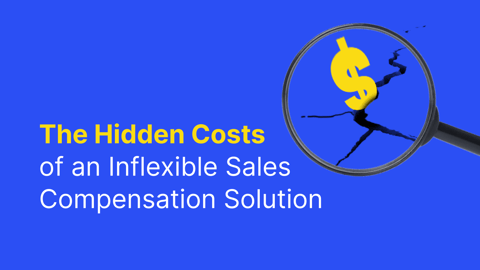Sales Operations, or SalesOps, is core to the any organization’s sales force – both internal and external. It's a broad term, often used interchangeably based on roles and expectations. In this blog post, we’ll define some of the specialties of this function.
SalesOps helps to optimize the efforts of the sales team, provide the proper guidance for success, and align the sellers to the organizational goals. So, what makes a good SalesOps team? Let's look at this from the perspective of Sales Performance Management.
SalesOps helps the Sellers (internal and external) to sell. For this conversation, we‘re going to look at three key areas:
- Sales Planning - Growth Forecast, Strategic Execution, and Plan Territory/ Quota assignments
- Sales Operations - Process Improvements, Efficiencies, Manage Territory/ Quota assignments, Commissions, and Motivations
- Sales Performance and Process - Automation of Process, Lead Generation, and Coachable Moments
SalesOps is not executing the sale, rather supporting the back office, the people, the processes, and anything in-between to direct, assist and motivate the seller in closing the deal.
There’s a lot to unpack as part of that statement, so let's start with the high-level strategic concerns.
SalesOps - Sales Planning
On a regular timeframe, or in response to market changes or strategic priority, an intersection of ideas come together for planning. This intersection involves the top-down expectations, bottom-up realities, sizing from Revenue Operations, Marketing and historical data, and future influencers and trends.
SalesOps for planning will work with a quorum of teams to align with performance metrics, incentives, drivers, enablement, and optimizations to culminate into a successful plan. Finance is an essential participant in this process. The data that feeds the historical perspective applied to the unique business questions should produce the evidence that will carry forward the executable operations. These are the goals, and through the growth forecasts and territory or quota plans, sellers are aligned to the expectations.
If you’re familiar with team sports such as football (or soccer), think of this as the pre-season efforts for a winning season. Team owners, recruiters, and coaches need to invest in bringing on the best talent not just to score a goal or win a game, but have a winning season. The goals aren’t just points scored on the field in the net or between the posts, it’s the ability to provide continuity of success. Is the equipment in good shape? Is everyone in the right state to win? Where can we coach to make improvements?
Another critical aspect of the strategic phase for SalesOps is to develop key plays. These might include the bundled offering, business lines, or recognition of revenue impact that will improve the bottom line.
For a sports analogy, which is played on a field, will we train? Are there defensive options for 1-1 or zone? In some of the sales plays, marketing may support plays better, where in others the offering may be enough. There are common and extreme factors (location, weather, injuries, opponent team changes), leadership changes (coach or QB changes), as well as the right team and player combinations for each scenario.
SalesOps - Sales Operations
Leadership and the cross-functional teams have put together a great plan with the SalesOps team. Now, it’s time for the coaches to come in to execute the plan through Sales Operations. It's the primary responsibility to get the sales team in the right condition for play. In this part of the cycle, Sales Operations looks at the administrative application of the plan. What’s the make-up of the team for each individual game? Are they the right fit for the game? Do we need to hire talent, or allow others to find another opportunity?
Before we go into the contract process, let's review the commission plans and agreements to align with the outcome of the desired goals. While we’d like to have the sellers focus on the "game," we don't want them "gaming" the system. The commission plans act as a contract between the organization and the individual/partner, defining what will get paid and rewarded for the right behaviors. In many companies, this will outgrow a spreadsheet quickly. Each dimension of the incentive adds complexity: multiple sellers, business lines, pay type, bonus, rewards, and splits. There will be additional complexity of contests or time-bound SPIFFs. Consider more robust processes to support SalesOps to ensure the accuracy and deliverability of accurate and timely payouts.
Team sports like football and soccer enter sophisticated contracts with players. These may include guaranteed payments, play on the field or pitch, team activities, performance level, or support when injured.
Transparency and open communication provide the ability to inculcate a process that eliminates errors and reduces disputes. It can improve the ability to motivate and reward for the right actions. This process is critical for the whole company; when this process goes bad, money and time are lost. In a poorly managed system, the recruitment and retention of top talent can be difficult. Companies that don’t have a reasonable process risk confidence in the team, could gain a poor reputation to work with and even put the brand at risk.
SalesOps - Sales Performance and Process
Plan complete, the contract signed, and the team ready to execute on operations—we're ready for the season to start.
During the selling period for a company, which could be a year, quarter, month, or unique timeframe, there’s a need to reflect on the plan and execution.
In football and soccer, we have a scoreboard. For each play of the game, the number of points earned, the time remaining, penalties and some of the opposing team (client) strategies are transparent. However, proactively planning for client changes (surprise plays) is what scores the goals or prevents being scored on.
During the season, similar team sports rankings make up a division or pool. Individuals get recognition for exceptional achievements and outstanding records.
The performance of the Account Manager and the sales team improve with similar transparencies. Individuals who know where they rank, how they perform, or how near they are to a tier or accelerator will motivate better habits and activities. Conversely, those who are underperforming or need those coachable moments can get the necessary assistance for improvement. This also allows their coach (manager) to have the facts necessary to have fact-based conversations.
Powerful applications of data help athletes improve performance. Sales Ops cannot improve things without analytics built on quality data. Cameras capture the kick, a swing, penalty or block for later review. Incremental improvements to sellers, as well as improving a response within the game or for future games (continuous planning) can be captured through powerful analytics. Where can you find better opportunities? Which opportunities are you more likely to win and close? Which step of the process can you improve to be better?
Improved processes, automation of systems, and improved enablement lead to improvements in the seller motivation, support and performance. Fewer errors, improved time with prospects, better matchups, and closer support are where the successful SalesOps team supports process and lead generation.
The Advantages of SalesOps
A good SalesOps team is looking to help the sales force. At every step of the process, this team can support the improvements to recognize the right revenues, improve an individual's performance, and remove the barriers that may slow or stop the team from success.
The inherent results of these improvements aren’t always apparent. Satisfied sellers have transparency. The opposite is also true. Unsatisfied sellers lack clarity. Lack of clarity can lead to doubt and distraction at best. Both can be remedied over time and by process improvements. If taken further, the one-time member of the team may find a lawyer and proceed with litigation. Or this may happen due to external regulatory oversight. To protect interests, successful organizations invest in Sales Performance Management systems that supply an inherent audit level of detail. These details can be provided in court to avoid expensive mistakes.
Good governance is also a non-obvious outcome of the investment of these systems. Home-built solutions frequently stop after the first iteration on investments. Third-party solutions will continue to enhance safe-keeping and compliance for regulatory change due to collective market intelligence
Payment accuracy is often the most recognized result of talented SalesOps teams taking full advantage of Sales Performance Management solutions. Research has shown that without these systems in place, as much as 7% overpayment or underpayment might be reoccurring.
Companies with more than 50 sellers or a growing level of complexity to reward beyond a straight commission need to seriously consider an investment in Sales Performance Management. The complexity comes from the inclusion of bonus packages, "grandfathered" programs, accelerated payout, or reward programs—just like picking multiple players (with terms) in a trade.
Larger companies who haven’t recently reviewed these process improvements with the SalesOps team, or haven’t recently invested in these areas, may not be fully realizing the potential of the go-to-market strategy.
Summary
For an entire decade, SaleOps focused on efficiency, that sellers only needed more time to sell, with fewer distractions. While those things remain true, today's sales force needs to focus on effectiveness. What will maximize the impact of the seller?
Sales Planning was the start of our conversation for a reason. SalesOps needs to be more strategic. Working with cross-functional bodies in Revenue Operations, Finance, and Marketing early in the process helps refine the right revenue, pursuit, and execution for go-to-market strategies.
Efficiency gains are still a best practice. You can't ignore them. Process improvements, striving for accuracy of data and payment, and providing the right motivators are all part of SalesOps core. To aid in this effort, the use of advanced analytics to continually ask "how can we improve" as the context applied to data will provide evidence. The evidence can support or disprove. Both are equally powerful in finding the right improvements.
SalesOps also have access to tools that can help promote healthy activities and schedules in client relationship management. "Maximizing the sales force" means not just the creation of leads, but the ability to use the full force of the sales pipe. Most organizations have a sales sieve, not a sales pipe, as valuable opportunities leak away. Find time with the seller for coachable moments or improve the opportunities potential as a trusted partner.
Sales Operations needs to...
- Be more involved in the planning and strategic process
- Continue to find and evolve process efficiency
- Focus on the full value of the sales pipe, reducing leaks, and multiply each step of the sales process
- Look to improve territory and account planning
- Get the right analytics supported by timely and detailed data
- Design sales enablement programs that align with strategic go-to-market plans



